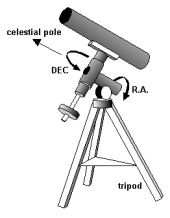German Equatorial Mounts
The purpose of the equatorial mount is to overcome the problems inherent in the alt-azimuth mount by aligning one of the axes of the mount parallel to the polar axis of the Earth, which then makes it possible to follow a celestial object by only a single movement. The most common form of such a mount is now generically known as the German equatorial.

By pointing the R.A. ( Right Ascension) axis to the celestial pole (in northern latitudes that will be roughly at the star Polaris), you can follow a star, or planet, by slowly turning the scope along this axis in the opposite direction to the Earth's rotation. For this purpose, most of these mounts are fitted with slow motion controls in order to allow you to slowly turn the axis in order to keep the object in view. The Dec ( Declination) axis allows you to change the ‘height’ of the scope above the celestial equator.
By attaching a small motor to the R.A. axis, and if the mount is adequately lined up with the Earth's axis, you will effectively be able to hold the image exactly in place, which makes it easier to view at higher magnifications, and it also allows you to use the scope to take long exposure photographs.
Not only is this mount more expensive than an alt-azimuth mount, it is also much heavier. One of the reasons is that, due to its construction, a counterweight is required to keep the scope in balance to make it easier to manoeuvre and point the telescope at the desired object. This means that the mount itself will weigh at least as much as the scope. In other words, if you have a heavy scope, a German equatorial mount will add at least the same weight, probably more, to the whole set-up, making this form of mount more unsuitable for fieldwork the larger the aperture of the scope.